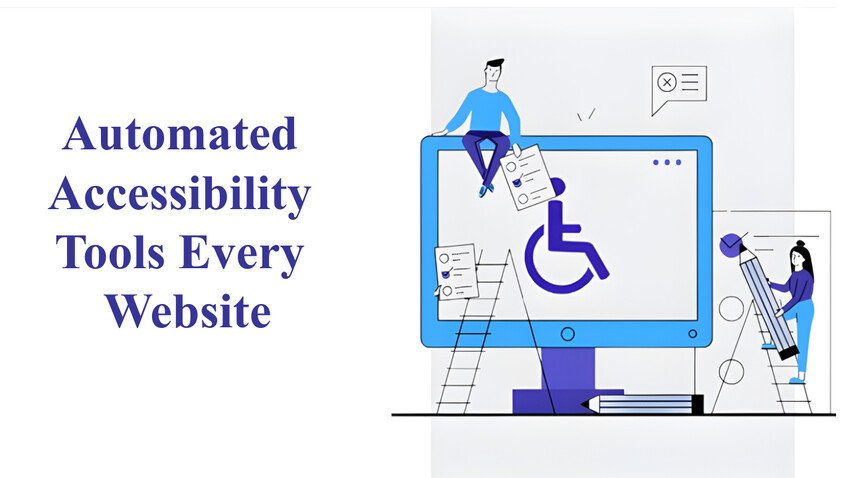Web access is no longer an option; it has become a necessity. With the increasing number of businesses and organizations becoming online, it is imperative to make sure that the digital content can be used by people with disabilities to comply with legal terms, be visible in search engines, and have a positive experience overall. Although manual accessibility testing is still an essential tool, automated accessibility tools have become a strong first line of defense. They assist in identifying frequent problems at a very fast rate, enhance the turnaround time, and assist the developers to develop inclusive websites effectively.
We will discuss the best automated accessibility testing tools that every webpage must employ and provide the rationale below.
Why Automated Accessibility Tools Matter
In automated tools, accessibility barriers, like the lack of alt text, low color contrast, keyboard navigation, incorrect ARIA labels, or wrong heading structure can be detected. These tools are useful to analyze the code, point out the errors and sometimes provide the solution, which is of great importance to developers, designers, and QA teams.
Although automation cannot substitute manual audits, it is capable of identifying almost 30%40% of accessibility problems immediately, which not only saves time but also makes the complete compliance process less expensive.
1. Axe by Deque Systems
Axe is an automated assessment tool that checks developers. It works well as a browser extension with Chrome and Firefox and also in CI/CD pipelines through its open-source API.
Key Features
- Quick, native research in a browser.
- Wcag standards-referenced detailed issue reports.
- Support plus options to integrate with Jest, Cypress, Selenium and other automation frameworks.
- Low false positives in comparison to other tools.
One of the most reliable tools in scalable testing of accessibility is Axe which assists developers in fixing accessibility problems during early phases of the development cycle.
2. Lighthouse by Google
Lighthouse is an open-source, free tool that is inbuilt within Google Chrome that scans through performance, SEO, best practice, and accessibility. Lighthouse only needs one click to complete a complete scan on accessibility and give a rating on a scale of 0 to 100.
Key Features
- Fast accessibility score to gain instant knowledge.
- Easy-to-understand reports
- Recommendations and explanations.
- A portion of the standard Chrome Dev Tools.
Although Lighthouse is not as comprehensive as dedicated accessibility scanners, it is suitable when one wants to do a quick check and also when a team wants to have an immediate reference point.
3. WAVE Web Accessibility Evaluation Tool
According to WebAIM, WAVE is a popular online assessment tool, which shows the accessibility errors graphically, right on the webpage. It particularly proves useful to content editors and non-technical users.
Key Features
- Visual overlays to identify problems with accessibility.
- Determines structural issues such as headings and ARIA roles.
- Quick scanning browser extensions.
- Ideal in editorial teams that are vetted.
WAVE is radiant in its capability to render the issue of accessibility visible, which can be handy in cases when designers, marketers, and QA testers would want visual feedback.
4. Accessibility Insights by Microsoft
The suite of accessibility testing tools introduced by Microsoft is called Accessibility Insights and is a powerful one. It provides quick automated tests and step-by-step instructional testing on the more advanced and manual testing.
Key Features
- Quick issue detection by automated FastPass scan.
- Over 50 directed manual examinations.
- Browser-based versions, android and windows versions.
- Combined code recommendations and WCAG sources.
This is a gap between automated and manual testing and therefore useful in addressing teams who want to enhance accuracy and efficiency.
5. Siteimprove Accessibility Checker
Siteimprove is a high-priced platform with a comprehensive level of accessibility analysis, monitoring, and reporting. It is not another scanner system but a workflow management system with compliance tracking.
Key Features
- Constant review of updates on websites.
- Priorities of issues depending on the level of WCAG success.
- Team working and workflow applications.
- Comprehensive enterprise reporting.
In the case of large organizations or businesses that operate more than one site, Siteimprove also offers the capacity of scalability as well as reporting necessary to maintain accessibility in the long run.
6. Tenon.io
Tenon is an automated accessibility testing API written as a flex library and made to be used by developers. It is compatible with all programming languages, and it can be easily integrated into DevOps pipelines.
Key Features
- Very versatile API to tailored testing systems.
- Embraces automated CI/CD.
- Prolific error messages that are developer friendly.
- Good WCAG and Section 508 advocacy.
Tenon can be of benefit particularly when the use of engineering teams requires constant testing to be done at multiple stages of development.
7. Pa11y
Pa11y is a free accessibility software that is useful when developers need automated testing but not under a paid platform.
Key Features
- Automated audit command-line interface.
- Produces HTML and JSON reports.
- Is able to carry out scheduled tests and track alterations.
- Blends well with building pipelines.
Pa11y is ideal for developers who are familiar with the command-line format and automation programs.
Final Thoughts
Automated accessibility tools provide a way to identify issues early, simplify compliance work and enhance your website’s usability. No automated tool can achieve full WCAG compliance without manual review, but these tools are a great starting point to establish a solid foundation for accessibility based on the combination of the tools above.
The tools range from browser extensions like Axe and WAVE to enterprise-level platforms like Siteimprove—these tools continue to enable your teams and potential users to engage with more inclusive, user-friendly, legally compliant digital experiences.



